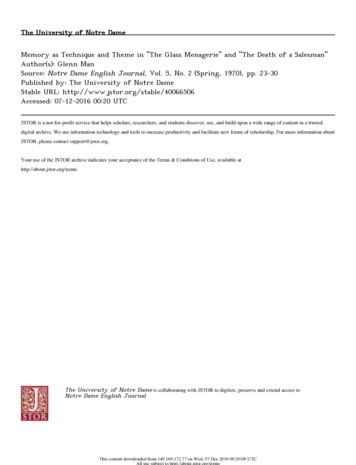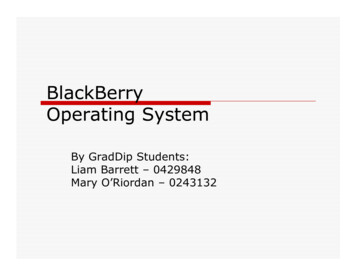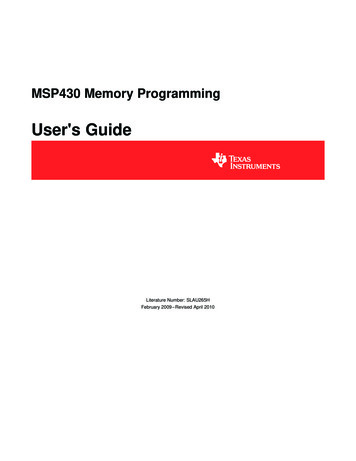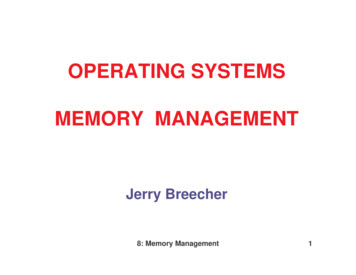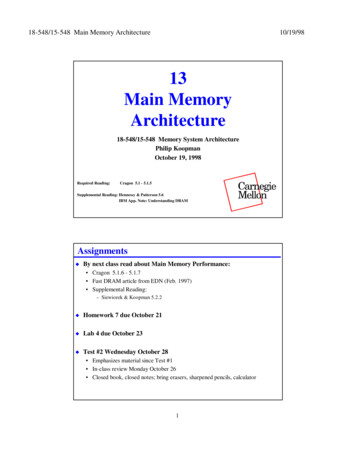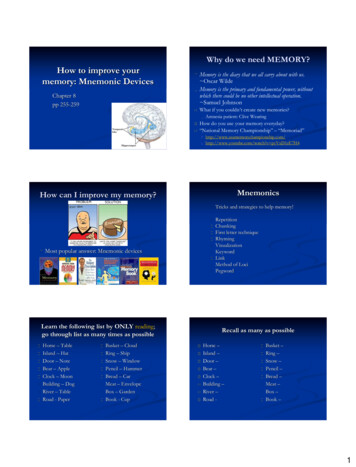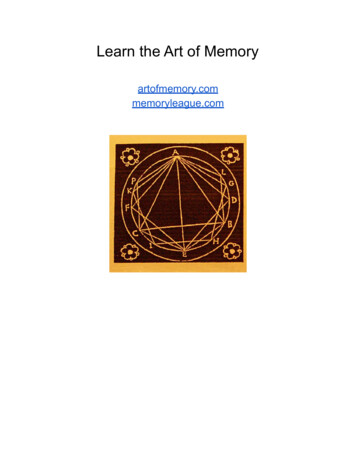
Transcription
Learn the Art of Memoryartofmemory.commemoryleague.com
1Table of ContentsINTRODUCTIONSTORIES AND LINKSALPHABET PEGSTHE METHOD OF LOCIHow It WorksNAMES AND FACESMEMORIZING NUMBERSNumber ShapesNumber RhymesNumber PegsLarger Number SystemsAssociation SystemMajor SystemOther SystemsMEMORIZING CARDSSuit Categories MethodMajor System MethodAdvanced Card MemorizationFREQUENTLY ASKED QUESTIONSWhat are the best memory books to read?How do I memorize a book?Where do I begin with memory techniques?How does one pronounce words like mnemotechnics and loci?How do I compete in a memory competition?How do I learn to memorize cards more quickly?What is the PAO system?How do I find more locations for my memory palaces?How do I memorize for tests?Where did memory techniques originate?How do I memorize formulas for math, physics, and chemistry?How do I memorize a dictionary?How do I learn mental calculation techniques?Share the Art of Memory 2022 Art of Memory / Memory League
2Please send comments and corrections to support@artofmemory.com. 2022 Art of Memory / Memory League
3INTRODUCTIONThis ebook is designed to give you a quick introduction to memory techniques that you can buildupon. The techniques are the same ones that we practice and teach on Art of Memory andMemory League.STORIES AND LINKSThe human mind has a natural ability to remember stories. We are also able to easily link thingsthat we don’t know with things that we already know. This is one of the fundamental principles ofthe Art of Memory.It becomes easier to remember unfamiliar information when we can link that information tosomething that we already know.Here is a simple exercise that demonstrates how linking concepts together makes themmemorable. I will give a list of word pairs. Try to picture the words as visual images and havethem interact with each other.So the first pair will consist of fireplace and apple. Imagine a fireplace and an apple, and linkthem together in your mind. For example: imagine roasting an apple in a fireplace. Strangeimages are memorable. 2022 Art of Memory / Memory League
4The second pair of words is composed of bowl and computer. You could imagine eating a bowlof food at your computer and spilling the food on your keyboard. Take a moment to picture thatimage.The third pair of words is flower and rhinoceros. Picture a rhinoceros charging into a giantflower, or maybe just wearing the flower behind its ear. You can exaggerate the associations tomake them memorable.Here is the complete list of word pairs for you to practice linking: fireplace – apple bowl – computer flower – rhinoceros money – library book – toothbrush lizard – pyramid fish – clownTake a moment to review them, and then turn to the next page. 2022 Art of Memory / Memory League
5Here is the list again, but with one word in each pair missing. Can you remember the missingword for each pair? Give it a try before f you are having trouble recalling the missing words, ask yourself, "what was happening in thefireplace?" or "what was the fish doing?” (Biting a clown's nose?)Don't worry if you don't get all of them on your first try. Go back to the original list of pairs, andtry linking them together again. All of this will become much quicker and easier with somepractice. 2022 Art of Memory / Memory League
6ALPHABET PEGSWe've learned a way to link image pairs together. We can now expand on this technique toremember long lists of things in order.The way it works is that we take an ordered list that we are already familiar with, like thealphabet or a sequence of numbers, and turn the list items into concrete things that we canvisualize.Let's start with an example that uses the alphabet.The English alphabet is a list of 26 letters that most people know how to recite in order: A, B, C,D, etc. We can turn each letter into a picture, and then associate something with each picture.We can then recite the alphabet back in order and recall the associations that we memorized.This will give us the ability to remember lists that are at least 26 items long.Let’s start with a list of 26 alphabet animals. You can change the animal names if you prefer touse different animals.1. A ant2. B bee3. C cat4. D dog5. E elephant6. F frog7. G giraffe8. H hippopotamus9. I iguana10. J jellyfish11. K kangaroo12. L lion13. M mouse14. N narwhal15. O owl16. P penguin17. Q quail18. R rabbit19. S snake20. T turtle21. U unicorn22. V vulture23. W woodpecker 2022 Art of Memory / Memory League
724. X x-ray fish25. Y yak26. Z zebraNow if you want to remember a list of things, you can associate each alphabet animal with eachitem in your list.Let’s assume that you are memorizing a list of people to u would take each animal peg and picture the animal interacting with that person. You canuse exaggeration here to make the images memorable.1.2.3.4.5.6.7.John is riding a giant ant (A).Sara is getting stung by a bee (B).A cat (C) is sitting on Bob’s head.Nancy is walking a dog (D).Jim is picking up an elephant (E).Laura is kissing a frog (F).Etc.Now to recall the items in order, just walk through the alphabet. The first letter is A, which is anant. Try to recall what the ant was doing, and you should see a giant ant being ridden like ahorse by John. To recall the next item, go to the next letter in the alphabet, B, find theassociated animal, a bee, and think about what the bee was doing. You can continue to gothrough the alphabet animals until you have recalled all of the items.If you can recite the alphabet backwards, you can also recite the memorized list itemsbackwards.You can create more than one alphabet peg list, by using different animals, objects, foods,names of celebrities, and more. See the alphabet peg list guide for more information. 2022 Art of Memory / Memory League
8THE METHOD OF LOCIOne of the most important techniques of advanced mnemonics is the method of loci. With thistechnique one creates imaginary journeys in the mind where one deposits mnemonic imagesthat represent the facts to be remembered. These journeys are often referred to as memorypalaces, mind palaces, or memory journeys.According to the Romans, the method of loci was invented somewhere around 2,500 years agoby a Greek poet named Simonides of Ceos though the technique is actually much older andgoes far back into to hunter-gatherer times.How It WorksTo create a memory journey (sometimes called a memory palace, though a memory palace isjust one kind of memory journey), you take a place that you know well and create specificlocations.Start by finding a room that you know well, for example, your bedroom. 2022 Art of Memory / Memory League
9We'll use the photograph below as an example.Image of bedroom is copyright Mojmir Churavy and used under a CC BY-SA 4.0 license. 2022 Art of Memory / Memory League
10After you have chosen a room for your memory journey, create an imaginary journey betweenfixed locations in the room. In this example, we'll choose four locations. In general, I like to gofrom left-to-right and top-to-bottom, where possible.The four locations in our memory journey are:1. Table2. Closet3. Left side of the bed4. Right side of the bed 2022 Art of Memory / Memory League
11Imagine that we have a list of things to memorize. This might seem like a strange list of things tomemorize, but we'll explain the reason for choosing these objects a bit later.1.2.3.4.OtterToolboxBeansShellImagine each item in the list occupying one location in your memory journey.LocationThing to memorizeTableOtterClosetToolboxLeft side of bedBeansRight side of bedShell 2022 Art of Memory / Memory League
12After you have placed the items in your memory journey, review it a few times by closing youreyes and mentally walking through the locations in order, trying to recall the objects that arecontained there.Before you go to sleep, walk through the memory journey once again.You should be able to recall the items in order, forwards and backwards, the next day and intothe future.1For large memorization projects, your memory journeys/palaces can contain hundreds oflocations (or more), but the basic technique is the same.Take a few moments to try memorizing the otter, toolbox, beans, and shell, because we'll usethem again later.Memory journeys are particularly good for remembering ordered lists: shopping listsvocabulary lists (when the order matters)to-do listsstudy noteslong numbershistory timelinesthe periodic table of elementsand much more!1If you're having difficulty with the technique, post in the Art of Memory Forum, and we'll help you get itworking! 2022 Art of Memory / Memory League
13NAMES AND FACESA basic way to memorize names is to use association between some feature on the person andtheir name. For example, to memorize that this man’s name is Jamal, you could imagine jam allover his hair.To memorize that this woman’s name is Teresa, imagine trees growing out of her glasses.The wiki has a comprehensive page on how to memorize names and faces. You can alsopractice memorizing names with the Memory League app. 2022 Art of Memory / Memory League
14MEMORIZING NUMBERSJust as with basic association techniques, memorizing numbers involves taking things that aredifficult to memorize (numbers) and associating them with things that are easy to picture in yourmind.Most number memorization systems rely on turning each number into a picture. We will startwith the easiest methods and work up to more advanced methods. 2022 Art of Memory / Memory League
15Number ShapesThe number shape system is a simple way to remember numbers that goes back at leasthundreds of years.Each digit is linked with an object or animal that looks like that number. For example the digit 0looks like a ball or an egg.The digit 1 looks kind of like a candle.Here is a list of ideas:0 looks like: a ball, egg, doughnut, or ring1 looks like: a candle, stick, or spear2 looks like: a swan3 looks like: a butterfly, handcuffs, or heart4 looks like: a flag or sailboat 2022 Art of Memory / Memory League
165 looks like: a hook, snake, Superman, or seahorse6 looks like: a cherry, elephant's trunk, golf club, or combination lock7 looks like: a boomerang or axe8 looks like: a snowman or hourglass9 looks like: a balloon on a stringHere's a practical example of using this simple number-shape system: if you have a doctorappointment at 2 PM and don't want to forget the time, you can convert the number 2 into avisual image that looks like a "2". A common mnemonic image for 2 is a swan.You can then picture a swan in your doctor's office. When you think about the doctor's office,you will remember "seeing" the swan there, and you can translate the swan image back into thenumber 2.The number shape system is one of the more basic number memorization techniques. It's usedfor remembering short numbers. For memorizing longer numbers, there are more powerfulnumber systems, like the Major System, described below.The wiki has more information and a video about number shape systems. 2022 Art of Memory / Memory League
17Number RhymesThe number rhymes system is another way of linking numbers with images, but instead ofusing the shape of the number, you create rhymes. Here are some examples:0 hero1 bun, sun, or gun2 shoe or gnu3 tree or sea4 door5 hive6 sticks7 heaven (you could use an image of an angel to distinguish it from a gate)8 bait (fishing) or gate9 wine, line, or mineThe wiki has more information about number rhyme systems.Both number shapes and number rhymes are very simple. They are not suitable for memorizingreally long numbers. For that you will need a dedicated system of 100 mnemonic images -- onefor each 2-digit number between 00 and 99. We'll explain how to do that below. 2022 Art of Memory / Memory League
18Number PegsNumbers can be used for creating peg lists, just like the alphabet. You could even use yourMajor System images (explained below) as pegs. Anytime that you have a list in your mind thatyou can keep in order (like the alphabet), you can use it as a peg list.Larger Number SystemsBigger number memorization tasks require larger mnemonic systems. A few are explainedbelow.Most memorizers create mnemonic images for every digit from 00 to 99 (100 images). Manycompetitive memorizers create images from 000 to 999 (1,000 images), or even 0000-9999(10,000 images) in at least one case.We'll explain how to create your 100 images from 00 to 99. Creating this system will give youthe tools to memorize numbers of any length -- from phone numbers, credit cards, and historydates, up to tens of thousands of digits of pi!Association SystemOne way to link numbers to images is to find associations between them.For example, the number 52 could be represented by a deck of playing cards, because a deckhas 52 cards.The number 00 could be represented by a bicycle, because it looks like the wheels of a bicycle.The number 64 could be represented by the Beatles, because of their song, When I'mSixty-four.In general, every memorizer chooses their own images, because everyone has differentassociations.The association technique has been proposed by three-time World Memory Champion, AndiBell. You can find a full example set of 100 images in the wiki.Major SystemThe Major System is probably the most common number-memorization system in use. Thoughthe history of the Major System goes back at least hundreds of years, its first publication in itsmodern form appears to have been written by Aimé Paris in 1825. 2022 Art of Memory / Memory League
19In the version of the Major System that we'll describe here, every possible two-digit number willbe converted into an image by translating the digits into consonant sounds and then finding animage that fits those consonants.The code for translating digits to consonants is:DigitConsonantsExplanation0z or s"Zero" starts with a z. The letter, s, is almost the sameconsonant as a z, but it doesn't use your vocal chords.1t or d1 looks like a t. The letter d is like a t that uses your vocalchords.2nThe letter n has 2 vertical lines. Also, if you turn the number2 on its side (and flip it), it looks kind of like an n.3mThe letter m has 3 vertical lines. Also, if you turn the number3 on its side, it looks like an m.4r“Four” ends with an r. 4 also resembles a backwards R.5LIf you hold out your left hand with the palm away from youand the thumb extended, your thumb and index finger makean L shape. There are 5 fingers on your hand.6ch, sh, j, zhThe sounds are: ch as in church j as in Juliet sh as in shell zh as in JacquesWhen you pronounce them, notice how the mouth position isthe same between ch and j, and also between sh and zh.The differences are that two of the consonants use vocalchords (j, zh) and two do not (ch, sh).7k or g7 is angular like the letter k. The consonant g is the onefound in grape, not George. It's a voiced relative of k.8f or v8 looks like a cursive f. The consonant v is a voiced k.9p or b9 looks like a backwards P. The letter b is a voiced p.To create an image from a two-digit number, convert each digit into a consonant using the tableabove. Then find a word that uses those two consonants as their first two consonants. Doubleletters that have one sound are counted as one consonant. So the word "llama" would be 53(LLaMa), not 55. 2022 Art of Memory / Memory League
20Here are some examples:NumberDigit #1Digit #2Image070 s/z7 k/giCe Cubes2111 t/d1 t/dToaDstool202 n0 s/zeiNStein999 p/b9 p/bBaBoonYou have already memorized eight digits of pi when you placed the otter, toolbox, beans, andshell in your memory palace. Each of those images represents a two-digit number:NumberDigit #1Digit #2Image141 t/d4 roTTeR151 t/d5 LTooLbox929 p/b2 nBeaNs656 sh/ch/zh/j5 LSHeLLThe first digits of pi are: 3.14159265. You can use this combination of the Major System and theMethod of Loci to memorize tens of thousands of digits of pi. We also have a page in the wikiabout the Major System that contains additional tips and Major System examples.Other SystemsIf you're interested in advanced number memorization systems, you might be interested inreading about the Dominic System, the Ben System, and binary number memorization systems.We have a video that provides an overview.You can practice memorizing numbers with Memory League and our other memory trainingsoftware.2Remember that the consonants of the Major System are not letters. The consonant sound "k" can berepresented by the letters: c ("cat"), k ("park"), ck ("back"), or even ch ("Pachelbel"). So even though theword "cubes" starts with a c, it maps to 7, because the consonant sound is like a k. However, the first c isan s sound, so it maps to 0. In a similar way, the ph in "philosopher" is translated into a 8 (f/v), becausethe sound of ph is "f". 2022 Art of Memory / Memory League
21MEMORIZING CARDSMemorizing card is similar to memorizing numbers. You can reuse your Major System imagesfor cards.The basic concept is that each of the 52 cards is assigned a fixed image. Those images getplaced in order in a memory journey. To recall the order, mentally walk through your memoryjourney and translate the images back into cards.There are several systems for translating cards into images, and we'll introduce a couple ofsimple ones here.Suit Categories MethodOne way to translate cards into images is to create categories based on the suits.For example:SuitCategoryExamplesSpadesToolsYou can use the Major System to convert the card values toletters, and then choose a tool that begins with that letter.Example: 4 is r in the Major System, so the 4 of spades couldbe a rope.HeartsLoveThis could include family, close friends, and anything elseassociated with love. Example: the 8 of Hearts could be thegoddess Venus, because 8 is an f or v in the Major System,andVenus starts with a v.DiamondsMoneyPeople or objects associated with wealth. Example: the King ofDiamonds could be Warren Buffett or Bill Gates.ClubsWarPeople or objects associated with war or aggression. Example:the King of Clubs could be Henry VIII or Alexander the Great. 2022 Art of Memory / Memory League
22Major System MethodIf you already have Major System images for 00 to 99, you can translate those same imagesinto card images. For example, you could translate them like this:SuitNumberReasonSpades00 is an s or z in the MajorSystem, and "spades" startswith an s.Hearts44 is an r in the Major System,and the word "hearts" has anr in it.Diamonds11 is a t or d in the MajorSystem, and "diamonds"starts with a d.Clubs77 is a k sound, and "clubs"starts with a "k" sound (eventhough it is written with theletter c).CardNumber Equivalent2 of spades20 (spades translates to a 0, using the tableabove)3 of spades304 of spades402 of hearts24 (hearts translates to a 4, using the tableabove)6 of hearts64Ace of diamonds11 (ace is 1, and diamonds translates to a 1,using the table above)10 of clubs07 (10 becomes zero, because ace is 1, andclubs translates to 7, using the table above) 2022 Art of Memory / Memory League
23For more information on memorizing cards, see the card color memorization tutorial, the cardmemorization techniques wiki page, and our discussions about by searching for "speed cards"in the Art of Memory Forum.You can practice memorizing cards on Memory League.Advanced Card MemorizationIf you are planning to compete in memory competitions, you might be interested in exploringmore advanced card memorization systems like the Ben System and Shadow System. Thesecard systems encode two cards per image, so they require many more images. 2022 Art of Memory / Memory League
24FREQUENTLY ASKED QUESTIONSHere are some frequently asked questions:What are the best memory books to read?There are hundreds of pages of free content in our memory techniques wiki. If you are lookingfor printed books, we have a for a few book recommendations. Many of our communitymembers have written books about memory too. You can find that information on our memorybooks recommendation page.How do I memorize a book?There is more than one way to memorize a book. Do you want to memorize a whole book or justthe most important concepts in a book? Start by reading How to Memorize a Book.Memorizing every word is a difficult task and will be time-consuming even with memorytechniques. There are cases of people who memorize entire dictionaries and long works ofpoetry, so if you want to attempt something like that, check out How to Memorize Verbatim Textwhich links to discussions about the topic.Where do I begin with memory techniques?First read through this PDF ebook to get a general overview. Then head over to our BeginnersPortal and forum to introduce yourself.How does one pronounce words like mnemotechnics andloci?The word loci means "locations" in Latin. It's the plural of locus, so onewould say: "1 locus and 2 loci". It is usually easier to call them"locations".In English, “loci” is most often pronounced like the first part of “loc-ation”,followed by “eye”. Some people pronounce it “low-sigh". You can readdiscussions about it here and here for a variety of opinions.Mnemotechnics is pronounced like the first part of "mnemo-nic", plus the"tech" in "tech-nology", and the "nics" at the end of "mnemo-nics". Itmeans "memory techniques". 2022 Art of Memory / Memory League
25The prefix, mnemo-, comes from the name Mnemosyne – the Greek goddess of memory.Mnemosyne is pronounced "nih-MOSS-in-ee".How do I compete in a memory competition?You can train for memory championships and participate in online competitions on MemoryLeague. See also our memory competition event calendar.How do I learn to memorize cards more quickly?Check out the card deck memorization thread, which has over 1,200 comments in it. Post yourcurrent speed there, and ask for advice. You can also practice card memorization and competeagainst your friends at Memory League.What is the PAO system?The PAO (person-action-object) system was popularized by the book Moonwalking withEinstein. You can learn about it on the PAO System page and in our Introduction to MemorizingNumbers video. There is also a page that contains PAO System examples.How do I find more locations for my memory palaces?See the wiki page on memory palace tips.How do I memorize for tests?This is a difficult question to answer without knowing about the kind of information that you willbe tested on. The best thing to do is to work through this book to become familiar with the basicmemory techniques. Then post a question in the Art of Memory Forum, being sure to includespecific examples of what you are trying to memorize. The more examples that you provide, theeasier it will be for people to help you.Where did memory techniques originate?According to the Romans, a Greek poet named Simonides invented the method of loci.However, it is probable that these location-based memory techniques were invented far earlier.The Major System can be traced back hundreds of years.A great introduction to the history of memory techniques in European culture can be found inFrances Yates' book, The Art of Memory. The Memory Code by Lynne Kelly is also excellentand highly recommended. Additional reading can be found on this list of memory books. 2022 Art of Memory / Memory League
26How do I memorize formulas for math, physics, andchemistry?Start with this forum thread. There are discussions about it here, here, here, and here too. Don'tmiss this great video of someone recalling 180 physics equations.People have differing ideas about the best way to do this:1.2.3.4.Use acrostics – see discussions here, here, and hereTurn every number and symbol into a mnemonic image like ShereshevskyForget mnemonic techniques and just try to understand the formulasOr combine the above techniques with memory palaces to keep the equations in orderWe suggest reading through those discussions and then posting any questions you have in theforum.How do I memorize a dictionary?Watch a short video about Dr. Yip Swee Chooi, who memorized a 1,774-page Chinese-Englishdictionary, and then check out dictionary memorization FAQ.How do I learn mental calculation techniques?You may want to start with a great book called Secrets of Mental Math by Arthur Benjamin andMichael Shermer. If you are visit the forum, a search icon will be available in the navbar. Typemental calculation into the search box, and there are some interesting discussions about it.If you are interested in mathematics, you may want to join these discussions: Systems for calculating calendar datesSpeed calculators: what is really useful to memorize?How to do divisions to many decimal places mentally?Stephen Hawking and mathAnzan Flash MethodCalculating 10 0.1 , 0.2, 0.3, etc.How to calculate squares quicklyEstimating square roots of non-perfect squaresDivision with 2 digits simultaneouslyAvoiding the carryDifference of squares - even faster multiplicationTrick for squaring 2 digit numbers above 50Squaring 2 digit numbers close to 100 2022 Art of Memory / Memory League
27 Guessing square roots quicklyLattice multiplication and drawing linesFamous mental calculatorsDiscussion of the limitations of mental calculation techniquesUsing the method of loci and mnemonics to learn multiplication tablesA new approach to calculating year keysEstimate moon phase for any dateAnalyzing Rüdiger Gamm’s performance (division by 167)Analyzing Rüdiger Gamm’s performance (division by 109)Do you have more questions? Post them in the forum, and we will answer them there!Share the Art of MemoryDid you find this booklet and website useful? Please share the Art of Memory with your friendsby clicking one of the buttons below:You can also share it on LinkedIn or copy/paste this link to share this PDF ebook directly:https://artofmemory.com/ebookSee you in the Art of Memory Forum and on Memory League! 2022 Art of Memory / Memory League
For large memorization projects, your memory journeys/palaces can contain hundreds of locations (or more), but the basic technique is the same. Take a few moments to try memorizing the otter, toolbox, beans, and shell, because we'll use them again later. Memory journeys are particularly good for remembering ordered lists: shopping lists



